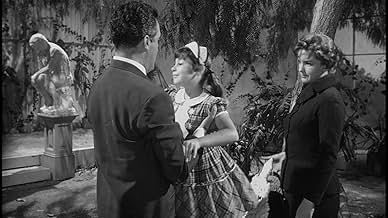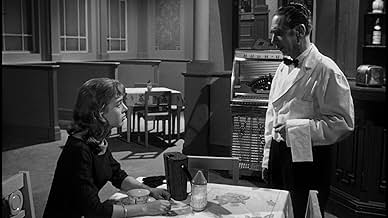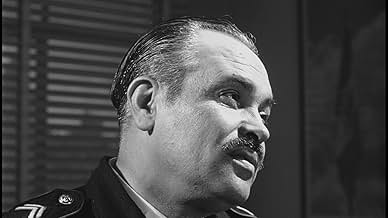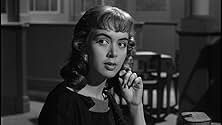Ajouter une intrigue dans votre langueGraverobbers stumble upon the tomb of a vampire, who turns them into zombies to do his bidding, which is to stalk and capture beautiful women.Graverobbers stumble upon the tomb of a vampire, who turns them into zombies to do his bidding, which is to stalk and capture beautiful women.Graverobbers stumble upon the tomb of a vampire, who turns them into zombies to do his bidding, which is to stalk and capture beautiful women.
- Réalisation
- Scénario
- Casting principal
Ariadne Welter
- Marta González
- (as Ariadna Welter)
Germán Robles
- Count Karol de Lavud
- (as German Robles)
Yerye Beirute
- Barraza
- (as Yeire Beirute)
Lourdes Azcarraga
- Víctima de vampiro
- (non crédité)
Irma Castillón
- Niña en hospital
- (non crédité)
Jorge Chesterking
- Turista museo
- (non crédité)
Felipe del Castillo
- Mesero
- (non crédité)
Jesús Gómez Murguía
- Policía
- (non crédité)
Carlos Hennings
- Turista museo
- (non crédité)
José Muñoz
- Comandante policía
- (non crédité)
Carlos Robles Gil
- Turista museo
- (non crédité)
Avis à la une
In Director Fernando Mendez' THE VAMPIRE'S COFFIN, a scientist steals the coffin of Count del Lavud (German Robles), in order to study the body. When the Count is inadvertently resurrected, a new spree of terror is unleashed. This time, he's out to exact his vengeance on those who killed him.
As sequels go, this is a good one. Abel Salazar and Ariadne Welter return in their roles from the first film. Once again, Mr. Robles is stellar as the Count. In probably the best scene of the entire movie, he stalks a woman down streets and alleys, casting some very creepy shadows. Another great scene takes place in a theater, where the Count and his thuggish henchman cause mayhem. This movie also makes use of a wax museum setting, where the finale takes place.
While not as impressive as the original, it's still a worthy follow-up...
As sequels go, this is a good one. Abel Salazar and Ariadne Welter return in their roles from the first film. Once again, Mr. Robles is stellar as the Count. In probably the best scene of the entire movie, he stalks a woman down streets and alleys, casting some very creepy shadows. Another great scene takes place in a theater, where the Count and his thuggish henchman cause mayhem. This movie also makes use of a wax museum setting, where the finale takes place.
While not as impressive as the original, it's still a worthy follow-up...
Graverobbers stumble upon the tomb of a vampire, who turns them into zombies to do his bidding, which is to stalk and capture beautiful women.
Dear Abel Salazar, you are an amazing actor with a great face. I wish you had been better-known to American horror audiences. Films like this, and especially "The Brainiac", have either been forgotten or became cult classics far too late.
When people speak of foreign horror, they often talk of Italian, or sometimes Japanese. These days Korean horror has become more fashionable, and the latest wave (as of 2015) is New Zealand. But who is out there blowing the trumpet for Mexico?
Dear Abel Salazar, you are an amazing actor with a great face. I wish you had been better-known to American horror audiences. Films like this, and especially "The Brainiac", have either been forgotten or became cult classics far too late.
When people speak of foreign horror, they often talk of Italian, or sometimes Japanese. These days Korean horror has become more fashionable, and the latest wave (as of 2015) is New Zealand. But who is out there blowing the trumpet for Mexico?
The Vampire's Coffin (1957)
*** (out of 4)
A doctor steals the corpse of vampire Count Lavud (German Robles) and soon those from the first film who destroyed him must try to do so again. Once again the Count is after Marta (Ariadna Welter) but Dr. Saldivar (Abel Salazar) is there to try and save the day.
This sequel to EL VAMPIRO is actually a lot better and manages to be one of the better vampire movies from this period. The movie fixes a lot of the problems with the first movie and manages to be a lot more entertaining thanks in large part to a nice atmosphere, a much better flow to the picture as well as some nice performances. The film kicks off with a great grave robbing sequence, which was obviously influenced by FRANKENSTEIN MEETS THE WOLF MAN but it's still a lot of fun.
From here we get a lot of very good scenes that manage to pack some nice atmosphere and of course the fog machine is on overdrive during most scenes. There's some very good stuff inside the hospital where two doctors debate on science and the idea of stealing the vampire's corpse. I thought the attack scenes were all extremely good and there's no doubt that the flow is much better here. The film manages to go by rather quickly and this certainly helps.
Another benefit is that the three leads are all very good. Robles is excellent as the vampire and manages to be quite menacing. Welter isn't given as much to do here as she did in the original but it's still nice seeing her return. Abel Salazar handles the role without any problems and makes for a memorable character. THE VAMPIRE'S COFFIN, like the first film, features some bad special effects with the wires attached to the flying bat being very noticeable but it doesn't do any major harm to the picture. If you're a fan of Mexican cinema then this here is a must see.
*** (out of 4)
A doctor steals the corpse of vampire Count Lavud (German Robles) and soon those from the first film who destroyed him must try to do so again. Once again the Count is after Marta (Ariadna Welter) but Dr. Saldivar (Abel Salazar) is there to try and save the day.
This sequel to EL VAMPIRO is actually a lot better and manages to be one of the better vampire movies from this period. The movie fixes a lot of the problems with the first movie and manages to be a lot more entertaining thanks in large part to a nice atmosphere, a much better flow to the picture as well as some nice performances. The film kicks off with a great grave robbing sequence, which was obviously influenced by FRANKENSTEIN MEETS THE WOLF MAN but it's still a lot of fun.
From here we get a lot of very good scenes that manage to pack some nice atmosphere and of course the fog machine is on overdrive during most scenes. There's some very good stuff inside the hospital where two doctors debate on science and the idea of stealing the vampire's corpse. I thought the attack scenes were all extremely good and there's no doubt that the flow is much better here. The film manages to go by rather quickly and this certainly helps.
Another benefit is that the three leads are all very good. Robles is excellent as the vampire and manages to be quite menacing. Welter isn't given as much to do here as she did in the original but it's still nice seeing her return. Abel Salazar handles the role without any problems and makes for a memorable character. THE VAMPIRE'S COFFIN, like the first film, features some bad special effects with the wires attached to the flying bat being very noticeable but it doesn't do any major harm to the picture. If you're a fan of Mexican cinema then this here is a must see.
EL Ataúd del Vampiro(1958), The Vampire's Coffin, is not a fitting sequel to El Vampiro,both featuring German Robles as aristocratic vampire Count Lavud. This sequel seems like a quickie followup. Most of the film is filmed inside modern buildings or building sets. It lacks the beautiful foreboding night fog scenes of the former. However, when I first wrote this review I had only seen the K. Gordon Murray dubbed version. I expressed thoughts that the Spanish version might be better. I have now seen the Casa Negra restored version in which the beautiful photography and music are quite apparent. The restored version DVD has both Spanish with and without English subtitles as well as the inferior K. Gordon Murray dubbed English version.
German Robles's acting is fine; he is quite the natty-charming-aristocratic-menacing-sensual vampire seeking Martha (Ariadna Welter) from the first movie. There is also an interesting scene in which he picks up a woman in a bar. He returns to this life?? thanks to a thief who becomes an assistant and acquires that status while attempting to steal the Count's large pendant and in the process pulling out the stake and thus bringing the Vampire back from the nether place to which he had been consigned in El Vampiro. The Count does not punish him but acknowledges his appreciation and makes him his assistant. (This is somewhat a precursor to Leo (Manver) the beguiling, willing hunchback assistant in the later Nostradamus films).
The Spanish restored Casa Negra version is part of a two DVD set with El Vampiro in both Spanish with and without English subtitles and dubbed English. The movie does now stand on its own and is worth seeing IN Spanish with or without English subtitles. I would now give it a 7.5 or 8 rating for its genre. IMDb will not allow any modification of my review of El Vampiro so I am unable to mention the quality of the Casa Negra restored version of El Vampiro; it is outstanding. I would add to my earlier review of that film that the photographic and sound quality are magnificent in the Casa Negra restored DVD.
Thomas J McKeon Indianapolis
German Robles's acting is fine; he is quite the natty-charming-aristocratic-menacing-sensual vampire seeking Martha (Ariadna Welter) from the first movie. There is also an interesting scene in which he picks up a woman in a bar. He returns to this life?? thanks to a thief who becomes an assistant and acquires that status while attempting to steal the Count's large pendant and in the process pulling out the stake and thus bringing the Vampire back from the nether place to which he had been consigned in El Vampiro. The Count does not punish him but acknowledges his appreciation and makes him his assistant. (This is somewhat a precursor to Leo (Manver) the beguiling, willing hunchback assistant in the later Nostradamus films).
The Spanish restored Casa Negra version is part of a two DVD set with El Vampiro in both Spanish with and without English subtitles and dubbed English. The movie does now stand on its own and is worth seeing IN Spanish with or without English subtitles. I would now give it a 7.5 or 8 rating for its genre. IMDb will not allow any modification of my review of El Vampiro so I am unable to mention the quality of the Casa Negra restored version of El Vampiro; it is outstanding. I would add to my earlier review of that film that the photographic and sound quality are magnificent in the Casa Negra restored DVD.
Thomas J McKeon Indianapolis
Mondo Macabro's R2 DVD of this film's prequel, THE VAMPIRE (1957), had included stills from the follow-up excerpted from its photo-novel edition (apparently included in full as a DVD-ROM extra on Casa Negra's 2-Disc R1 Set "The Vampire Collection"); at the time, the synopsis had felt contrived and, therefore, I had anticipated that the film itself would be inferior to the original (though I'm still disappointed that there's no Audio Commentary to accompany it!). Having watched THE VAMPIRE'S COFFIN now - and re-acquainted myself with its predecessor (the very first Mexican horror effort I'd seen), which didn't disappoint - I can only confirm this!
Anyway, the original was largely set at a dilapidated hacienda in a remote village - with characters dressed in old-style clothing and an overpowering foggy atmosphere - so that it was jarring to see these same characters (or who was left standing among them) transposed to modern city surroundings! Apparently, the film-makers purposely opted to make the sequel as different as possible to its predecessor - and, while that same Gothic mood is felt on occasion, the three main settings of the film, i.e. hospital, wax museum and burlesque theater, elicit their own particular ambiance with which the vampire character may not always be compatible (for instance, he appears outside a bar to stalk an aspiring young female performer incongruously dressed in his traditional cape...and, yet, she never for a moment suspects his true intentions, in fact welcomes the stranger's advances by throwing flirtatious glances at him herself)!
The music score is typically overstated (as far as I can tell replicating that of the original, where it seemed to work better!) and the special effects pretty ropey - especially the very visible wires holding the supposedly flying bat, but also the number of times that the vampire is seen reflected in a mirror when it's made clear that he shouldn't!; that said, the transition from vampire to bat is, once again, neatly enough done. The most atmospheric moments are those set in the wax museum with its numerous torture devices (though the climax is a rather awkward mess!), and the large shadows thrown by the vampire on the various buildings in the afore-mentioned stalking sequence (in fact, the film-makers seem to have liked this effect so much that the scene is absurdly extended, when the vampire could very easily have rendered himself invisible at any moment and let the girl simply fall into his clutches - as he does, eventually!). Resting largely on the shoulders of lead/producer Abel Salazar, the comic relief comes off remarkably well (particularly in scenes where he has to explain his tall tale about disappearing coffins and rampaging vampires to his superiors or the police) and, in fact, my relative disappointment with the film isn't due to any intrinsic campiness - as was the case with THE BRAINIAC (1962), for instance - though, as per reviews I've read of the English-dubbed U.S. version prepared by K. Gordon Murray (included on the DVD but which I haven't checked out), it's a different matter altogether!
As for the principal cast members, Salazar is, again, an engaging hero; likewise, Ariadne Welter is lovely throughout (even when engaged in a sleazy dance number!) - but German Robles fares less well than in the first film (where he had cut a suitably imposing figure), here tending to come off as merely nonchalant...and a veritable Elvis Costello look-alike to boot! The evidently rushed production, then, ultimately brings (perhaps unkind) comparisons - with respect to the difference in quality between the two films - to SON OF KONG (1933) when stacked up against its monumental prequel!
Anyway, the original was largely set at a dilapidated hacienda in a remote village - with characters dressed in old-style clothing and an overpowering foggy atmosphere - so that it was jarring to see these same characters (or who was left standing among them) transposed to modern city surroundings! Apparently, the film-makers purposely opted to make the sequel as different as possible to its predecessor - and, while that same Gothic mood is felt on occasion, the three main settings of the film, i.e. hospital, wax museum and burlesque theater, elicit their own particular ambiance with which the vampire character may not always be compatible (for instance, he appears outside a bar to stalk an aspiring young female performer incongruously dressed in his traditional cape...and, yet, she never for a moment suspects his true intentions, in fact welcomes the stranger's advances by throwing flirtatious glances at him herself)!
The music score is typically overstated (as far as I can tell replicating that of the original, where it seemed to work better!) and the special effects pretty ropey - especially the very visible wires holding the supposedly flying bat, but also the number of times that the vampire is seen reflected in a mirror when it's made clear that he shouldn't!; that said, the transition from vampire to bat is, once again, neatly enough done. The most atmospheric moments are those set in the wax museum with its numerous torture devices (though the climax is a rather awkward mess!), and the large shadows thrown by the vampire on the various buildings in the afore-mentioned stalking sequence (in fact, the film-makers seem to have liked this effect so much that the scene is absurdly extended, when the vampire could very easily have rendered himself invisible at any moment and let the girl simply fall into his clutches - as he does, eventually!). Resting largely on the shoulders of lead/producer Abel Salazar, the comic relief comes off remarkably well (particularly in scenes where he has to explain his tall tale about disappearing coffins and rampaging vampires to his superiors or the police) and, in fact, my relative disappointment with the film isn't due to any intrinsic campiness - as was the case with THE BRAINIAC (1962), for instance - though, as per reviews I've read of the English-dubbed U.S. version prepared by K. Gordon Murray (included on the DVD but which I haven't checked out), it's a different matter altogether!
As for the principal cast members, Salazar is, again, an engaging hero; likewise, Ariadne Welter is lovely throughout (even when engaged in a sleazy dance number!) - but German Robles fares less well than in the first film (where he had cut a suitably imposing figure), here tending to come off as merely nonchalant...and a veritable Elvis Costello look-alike to boot! The evidently rushed production, then, ultimately brings (perhaps unkind) comparisons - with respect to the difference in quality between the two films - to SON OF KONG (1933) when stacked up against its monumental prequel!
Le saviez-vous
- AnecdotesThere is a smiling skull-and-crossbones insignia on the posters and lobby cards, with the words "Recommended by Young America Horror Club". There was no such organization, it was an invention of producer K. Gordon Murray to boost ticket sales.
- GaffesEvery time Count Luvud turns into a bat and flies around, you can see the wires holding the bat.
- ConnexionsFeatured in Horrible Horror (1986)
Meilleurs choix
Connectez-vous pour évaluer et suivre la liste de favoris afin de recevoir des recommandations personnalisées
Détails
- Date de sortie
- Pays d’origine
- Langue
- Aussi connu sous le nom de
- Le retour du vampire
- Lieux de tournage
- Estudios Churubusco Azteca, Ville de Mexico, Distrito Federal, Mexique(studios, as Churubusco-Azteca, S.A.)
- Société de production
- Voir plus de crédits d'entreprise sur IMDbPro
- Durée
- 1h 20min(80 min)
- Couleur
- Rapport de forme
- 1.37 : 1
Contribuer à cette page
Suggérer une modification ou ajouter du contenu manquant


























